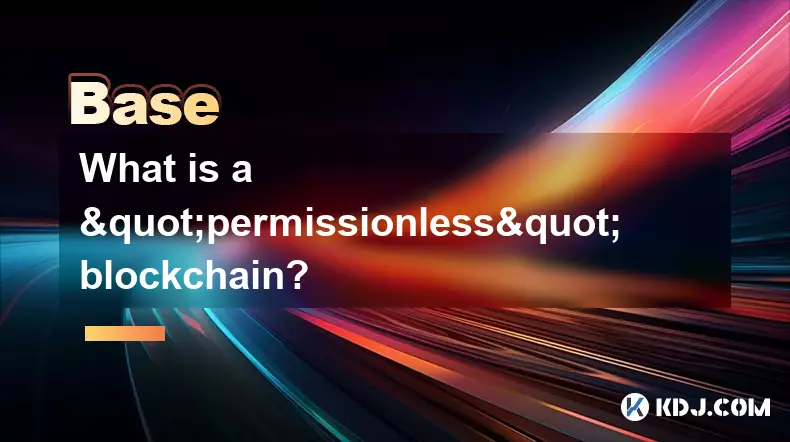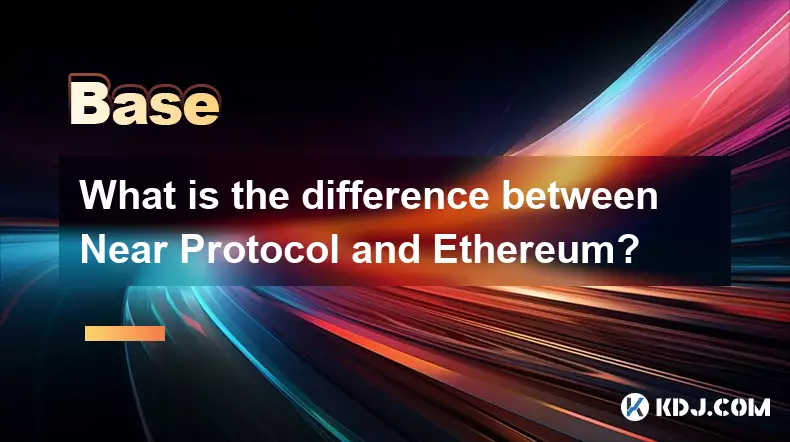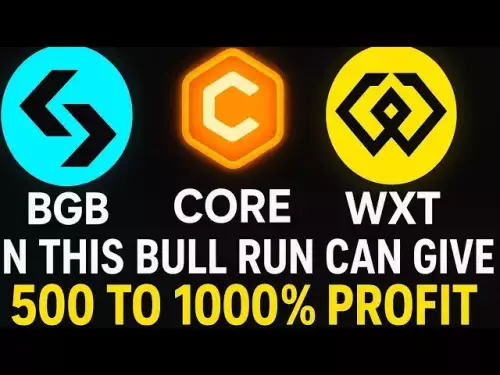-
 bitcoin
bitcoin $110311.910091 USD
1.97% -
 ethereum
ethereum $3964.172463 USD
0.34% -
 tether
tether $1.000288 USD
-0.05% -
 bnb
bnb $1098.563056 USD
-0.37% -
 xrp
xrp $2.479902 USD
4.31% -
 solana
solana $188.301025 USD
1.38% -
 usd-coin
usd-coin $0.999961 USD
0.01% -
 tron
tron $0.322477 USD
0.49% -
 dogecoin
dogecoin $0.199450 USD
2.51% -
 cardano
cardano $0.662393 USD
2.33% -
 hyperliquid
hyperliquid $37.947663 USD
1.71% -
 chainlink
chainlink $18.819081 USD
9.53% -
 ethena-usde
ethena-usde $0.999345 USD
-0.04% -
 stellar
stellar $0.323467 USD
2.06% -
 bitcoin-cash
bitcoin-cash $479.282126 USD
1.50%
What is a "permissionless" blockchain?
Permissionless blockchains enable open, trustless participation through decentralized consensus, allowing anyone to validate transactions and contribute to network security without central oversight.
Oct 19, 2025 at 03:22 am

Understanding Permissionless Blockchains
1. A permissionless blockchain operates without centralized control, allowing anyone to join the network and participate in the consensus process. No gatekeeping authority restricts access, making it fully open to users worldwide. This openness is one of the core tenets of decentralization.
2. Participants can validate transactions, mine new blocks, or run full nodes without needing approval from a central entity. This model relies on cryptographic proof and economic incentives to maintain security and integrity across the distributed ledger.
3. Bitcoin is the most prominent example of a permissionless blockchain. It introduced a trustless system where miners compete to add blocks using proof-of-work, and every node independently verifies the chain’s history.
4. The absence of identity verification or access restrictions means pseudonymity is standard. Users interact through public addresses, enhancing privacy but also posing challenges for regulatory compliance in certain jurisdictions.
5. Because no single party governs the network, changes to the protocol require broad community consensus. Forks may occur when disagreements arise about upgrades or rule modifications, reflecting the decentralized nature of decision-making.
Key Features of Decentralized Access
1. Open participation enables innovation by lowering entry barriers for developers and entrepreneurs. Anyone can deploy smart contracts or build decentralized applications (dApps) on platforms like Ethereum without seeking permission.
2. Network resilience increases as more independent nodes contribute to validation and data storage. Censorship resistance emerges naturally since no central point exists to target or shut down.
3. Trust is established through code and consensus mechanisms rather than institutional authority. Users rely on transparent algorithms and verifiable transaction histories instead of intermediaries.
4. Incentive structures align participant behavior with network health. Miners or validators earn rewards for honest contributions, while malicious actions are economically disincentivized.
5. Global accessibility allows individuals in regions with unstable financial systems to engage in secure value transfer and digital ownership, promoting financial inclusion.
Challenges and Trade-offs
1. Scalability remains a persistent issue due to the overhead of maintaining consensus across thousands of nodes. Transaction throughput often lags behind centralized alternatives, leading to congestion during peak usage.
2. Energy consumption associated with proof-of-work blockchains has drawn criticism, prompting shifts toward more efficient consensus models like proof-of-stake. Environmental impact influences public perception and regulatory scrutiny.
3. Immutability and irreversibility of transactions protect against tampering but complicate recovery in cases of user error or fraud. Lost private keys or accidental transfers result in permanent loss of assets.
4. Anonymity features attract illicit activity, complicating efforts to combat money laundering or terrorist financing. Regulatory bodies increasingly demand transparency tools and know-your-customer (KYC) integration.
5. Governance becomes complex without formal hierarchies. Disputes over protocol direction can fragment communities and lead to contentious hard forks, diluting network effects.
Common Questions About Permissionless Blockchains
Q: How do permissionless blockchains prevent spam attacks?A: They use economic deterrents such as transaction fees and computational requirements. For example, sending a transaction requires paying a fee, making large-scale spam prohibitively expensive.
Q: Can governments shut down permissionless blockchains?A: Due to their distributed architecture, shutting them down entirely is extremely difficult. Even if some nodes are disabled, others continue operating, preserving the network.
Q: Are all cryptocurrencies built on permissionless blockchains?A: No. Some projects use permissioned or hybrid models where validators are pre-approved. These are common in enterprise solutions prioritizing compliance and performance over full decentralization.
Q: What role do consensus mechanisms play in permissionless systems?A: Consensus mechanisms like proof-of-work or proof-of-stake ensure agreement on the state of the ledger without central coordination. They validate transactions and secure the network against double-spending and other threats.
Disclaimer:info@kdj.com
The information provided is not trading advice. kdj.com does not assume any responsibility for any investments made based on the information provided in this article. Cryptocurrencies are highly volatile and it is highly recommended that you invest with caution after thorough research!
If you believe that the content used on this website infringes your copyright, please contact us immediately (info@kdj.com) and we will delete it promptly.
- Decoding the Crypto Landscape: Ozak AI, TRON, and the AI Revolution
- 2025-10-22 09:10:17
- Bitcoin Price Rollercoaster: Crash, Predictions, and Reasons Why
- 2025-10-22 09:07:34
- Decoding Bitcoin's Strategy Amidst Market Volatility: A New Yorker's Take
- 2025-10-22 09:07:34
- Kadena's Shutdown Operations: What Happened to the KDA Token?
- 2025-10-22 09:07:34
- Kadena (KDA) Coin Price Drop: What's Going On?
- 2025-10-22 09:07:34
- Token Resistance, Security, and Blockchain: Navigating the New Normal
- 2025-10-22 09:07:34
Related knowledge

How do decentralized identity (DID) solutions work?
Oct 14,2025 at 11:36pm
Understanding Decentralized Identity in the Blockchain Ecosystem1. Decentralized identity (DID) solutions are built on blockchain networks, allowing i...

What is the difference between Near Protocol and Ethereum?
Oct 15,2025 at 08:01am
Near Protocol and Ethereum: Core Architectural Differences1. Near Protocol operates on a sharded blockchain architecture known as Nightshade, which al...

What does it mean for code to be "open source" in crypto?
Oct 12,2025 at 01:54pm
Understanding Open Source in the Cryptocurrency Ecosystem1. In the context of cryptocurrency, open source refers to software whose code is publicly ac...

What is the purpose of a "testnet"?
Oct 12,2025 at 09:01am
Understanding the Role of Testnets in Blockchain Development1. A testnet serves as a parallel version of a blockchain network, designed specifically f...

How to avoid phishing scams in crypto?
Oct 13,2025 at 06:18pm
Understanding Common Crypto Phishing Tactics1. Cybercriminals frequently use fake websites that mirror legitimate crypto exchanges or wallet platforms...

What is the difference between single-collateral and multi-collateral Dai?
Oct 12,2025 at 05:18pm
Understanding Single-Collateral Dai1. Single-Collateral Dai (SCD) was the original version of the Dai stablecoin launched by MakerDAO in 2017. It allo...

How do decentralized identity (DID) solutions work?
Oct 14,2025 at 11:36pm
Understanding Decentralized Identity in the Blockchain Ecosystem1. Decentralized identity (DID) solutions are built on blockchain networks, allowing i...

What is the difference between Near Protocol and Ethereum?
Oct 15,2025 at 08:01am
Near Protocol and Ethereum: Core Architectural Differences1. Near Protocol operates on a sharded blockchain architecture known as Nightshade, which al...

What does it mean for code to be "open source" in crypto?
Oct 12,2025 at 01:54pm
Understanding Open Source in the Cryptocurrency Ecosystem1. In the context of cryptocurrency, open source refers to software whose code is publicly ac...

What is the purpose of a "testnet"?
Oct 12,2025 at 09:01am
Understanding the Role of Testnets in Blockchain Development1. A testnet serves as a parallel version of a blockchain network, designed specifically f...

How to avoid phishing scams in crypto?
Oct 13,2025 at 06:18pm
Understanding Common Crypto Phishing Tactics1. Cybercriminals frequently use fake websites that mirror legitimate crypto exchanges or wallet platforms...

What is the difference between single-collateral and multi-collateral Dai?
Oct 12,2025 at 05:18pm
Understanding Single-Collateral Dai1. Single-Collateral Dai (SCD) was the original version of the Dai stablecoin launched by MakerDAO in 2017. It allo...
See all articles










































































